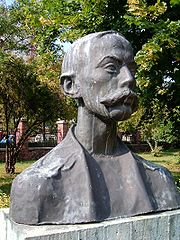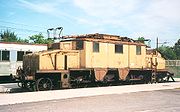
Kálmán Kandó
Encyclopedia

Hungary
Hungary , officially the Republic of Hungary , is a landlocked country in Central Europe. It is situated in the Carpathian Basin and is bordered by Slovakia to the north, Ukraine and Romania to the east, Serbia and Croatia to the south, Slovenia to the southwest and Austria to the west. The...
engineer
Engineer
An engineer is a professional practitioner of engineering, concerned with applying scientific knowledge, mathematics and ingenuity to develop solutions for technical problems. Engineers design materials, structures, machines and systems while considering the limitations imposed by practicality,...
, and a pioneer in the development of electric railway traction.
Education
He was educated at the Budapest Technical University where he gained a diploma in mechanical engineering. He worked in FranceFrance
The French Republic , The French Republic , The French Republic , (commonly known as France , is a unitary semi-presidential republic in Western Europe with several overseas territories and islands located on other continents and in the Indian, Pacific, and Atlantic oceans. Metropolitan France...
as a junior engineer designing and developing Nikola Tesla
Nikola Tesla
Nikola Tesla was a Serbian-American inventor, mechanical engineer, and electrical engineer...
's induction motor
Induction motor
An induction or asynchronous motor is a type of AC motor where power is supplied to the rotor by means of electromagnetic induction. These motors are widely used in industrial drives, particularly polyphase induction motors, because they are robust and have no brushes...
.
Work on railway electrification
In 1894, Kálmán Kandó developed high-voltage three phase alternating currentAlternating current
In alternating current the movement of electric charge periodically reverses direction. In direct current , the flow of electric charge is only in one direction....
motors and generators
Electrical generator
In electricity generation, an electric generator is a device that converts mechanical energy to electrical energy. A generator forces electric charge to flow through an external electrical circuit. It is analogous to a water pump, which causes water to flow...
for electric locomotive
Electric locomotive
An electric locomotive is a locomotive powered by electricity from overhead lines, a third rail or an on-board energy storage device...
s ; he is known as the father of the electric train. His work on railway electrification was done at the Ganz
Ganz
The Ganz electric works in Budapest is probably best known for the manufacture of tramcars, but was also a pioneer in the application of three-phase alternating current to electric railways. Ganz also made / makes: ships , bridge steel structures , high voltage equipment...
electric works in Budapest
Budapest
Budapest is the capital of Hungary. As the largest city of Hungary, it is the country's principal political, cultural, commercial, industrial, and transportation centre. In 2011, Budapest had 1,733,685 inhabitants, down from its 1989 peak of 2,113,645 due to suburbanization. The Budapest Commuter...
. He was the first who recognised that an electric train system can only be successful if it can use the electricity from public networks.
After his achievement in designing the three-phase motor and generator he moved to Italy
Italy
Italy , officially the Italian Republic languages]] under the European Charter for Regional or Minority Languages. In each of these, Italy's official name is as follows:;;;;;;;;), is a unitary parliamentary republic in South-Central Europe. To the north it borders France, Switzerland, Austria and...
. He would later return to Budapest to work at the Ganz factory where he became the managing director.
Italy

Valtellina
Valtellina or the Valtelline valley ; is a valley in the Lombardy region of northern Italy, bordering Switzerland. Today it is known for its skiing, its hot spring spas, its cheeses and its wines...
railway line was electrified in 1902 and became Europe's first electrified main railway line.
For the Valtellina line, three-phase power was supplied at about 3,000 volts through two overhead lines, while the running rails supplied the third phase. At junctions, the two overhead lines had to cross and this prevented the use of very high voltages.
The three-phase, two wire, system was used on several railways in Northern Italy
Northern Italy
Northern Italy is a wide cultural, historical and geographical definition, without any administrative usage, used to indicate the northern part of the Italian state, also referred as Settentrione or Alta Italia...
and became known as "the Italian system". There are now few railways which use this system.
Hungary

Phase converter
Single-phase power was supplied at 16,000 volts and 50 Hz through a single overhead line and converted to three-phase on the locomotive by a rotary phase converter
Rotary phase converter
A rotary phase converter, abbreviated RPC, is an electrical machine that produces three-phase electric power from single-phase electric power. This allows three phase loads to run using generator or utility-supplied single-phase electric power....
. The drive motors, made by Metropolitan-Vickers
Metropolitan-Vickers
Metropolitan-Vickers, Metrovick, or Metrovicks, was a British heavy electrical engineering company of the early-to-mid 20th century formerly known as British Westinghouse. Highly diversified, they were particularly well known for their industrial electrical equipment such as generators, steam...
, had a very large diameter of 3 meters and incorporated four sets of 24 magnetic poles each, which could be added to the traction effort at will, producing highly efficient constant speeds of 25, 50, 75 and 100 km/h over rail (or 17/34/51/68 km/h for the V60 heavy freight train engine variant, which had six pairs of smaller driving wheels).
Power factor
A major benefit of this arrangement was a power factor
Power factor
The power factor of an AC electric power system is defined as the ratio of the real power flowing to the load over the apparent power in the circuit, and is a dimensionless number between 0 and 1 . Real power is the capacity of the circuit for performing work in a particular time...
rate of nearly 1.00 in the catenary-attached equipment, which fulfilled the electric powerplants' strict load-distributing regulations. The unacceptably poor cosine phi rate of pre-World War II
World War II
World War II, or the Second World War , was a global conflict lasting from 1939 to 1945, involving most of the world's nations—including all of the great powers—eventually forming two opposing military alliances: the Allies and the Axis...
design electric motors (occasionally as low as 0,65) was not felt outside the Kando locomotives, as the phase changer machinery isolated it from the catenary.
Speed control
Intermediate speeds were maintained by connecting a water and saltpeter based adjustable resistor to the line, which reduced the efficiency of the locomotive. Timetables for electrified lines were supposed to allow use of full efficiency constant speeds most of the time but, in practice, the need to share the track with trains hauled by MÁV Class 424 steam locomotive
Steam locomotive
A steam locomotive is a railway locomotive that produces its power through a steam engine. These locomotives are fueled by burning some combustible material, usually coal, wood or oil, to produce steam in a boiler, which drives the steam engine...
s meant the water-hungry and wasteful "gearbox resistor" had to be used often.
Kandó triangle drive
The propulsive force was transferred to the locomotive's wheels using a traditional pushrod system, designed to provide manufacturing and maintenance commodity to the predominantly steam-based Hungarian Railways (MÁV) of the time. The so-called "Kandó triangle" arrangement transferred power from the electric motor to the pushrods in such a way that no oblique forces were exerted on the chassis, making the V40 less hurtful to the rail track compared to steam engines. In practice the V40 pushrod system was too precise for steam-era habits based maintenance and required more frequent care.
Shaft drive
More than a decade after Kandó's death two new, shaft-driven prototypes of his design were built by the Ganz company, to allow for 125 km/h traction speeds. The V44 electric locomotives proved too heavy for general use, owing to their 22 metric ton per axle rail load. Both vehicles were eventually destroyed in USAAF bombing raids in 1944, running only 16,000 kilometers overall.
Bogie-mounted motors
After the World War Two, a last series of electric phase-changer locomotives were built by the new communist government in Hungary. Owing to Cold War
Cold War
The Cold War was the continuing state from roughly 1946 to 1991 of political conflict, military tension, proxy wars, and economic competition between the Communist World—primarily the Soviet Union and its satellite states and allies—and the powers of the Western world, primarily the United States...
restrictions, the innovative V55 type, which used bogie-mounted motors, had to be constructed of domestic components entirely and suffered from reliability problems in their double-conversion phase-changer / frequency-changer propulsion system. (The traction motors of pre-WWII V40 and V60 locomotives were made in Britain by the Metropolitan-Vickers company, as part of an economic aid programme organized by Lord Rothermere.)
Preservation
Currently one example of the V40, the V55 and the V60 locomotive each survives. They are preserved at the Budapest Railway History Park, but require restoration after decades of open air static display. If funding permits, the repaired V40 may return to the open track for "nostalgic service", with a semiconductor front-end added to its system for 25 to 16 kV AC down-step conversion.
France
He designed in 1926 the 1.5kV DC 2BB2 400 (:fr:2BB2 400) for the Paris-Orleans line which were the strongest DC locomotives in Europe at that time.United Kingdom
There were plans to use the two-wire, three-phase, system on the Portmadoc, Beddgelert and South Snowdon RailwayPortmadoc, Beddgelert and South Snowdon Railway
The Porthmadog, Beddgelert and South Snowdon Railway was a narrow gauge railway intended to connect Porthmadog with the North Wales Narrow Gauge Railways link terminus at Rhyd Ddu...
in Wales
Wales
Wales is a country that is part of the United Kingdom and the island of Great Britain, bordered by England to its east and the Atlantic Ocean and Irish Sea to its west. It has a population of three million, and a total area of 20,779 km²...
and the Metropolitan Railway
Metropolitan railway
Metropolitan Railway can refer to:* Metropolitan line, part of the London Underground* Metropolitan Railway, the first underground railway to be built in London...
in London
London
London is the capital city of :England and the :United Kingdom, the largest metropolitan area in the United Kingdom, and the largest urban zone in the European Union by most measures. Located on the River Thames, London has been a major settlement for two millennia, its history going back to its...
but neither of these plans came to fruition.
Kandó's legacy
Kálmán Kandó died at Budapest in 1931 but his work lives on. Many modern electric trains work on the same three-phase high tension AC principle introduced by the Kandó V40 locomotives, but the rotary converter is replaced by semiconductorSemiconductor
A semiconductor is a material with electrical conductivity due to electron flow intermediate in magnitude between that of a conductor and an insulator. This means a conductivity roughly in the range of 103 to 10−8 siemens per centimeter...
devices. Three-phase powered electric motors allow for high traction effort even at great speeds and the difficulty of maintaining arbitrary speeds at full efficiency is eliminated by using IGBT semiconductors and the use of digital controls.
See also
- Railway electrification systemRailway electrification systemA railway electrification system supplies electrical energy to railway locomotives and multiple units as well as trams so that they can operate without having an on-board prime mover. There are several different electrification systems in use throughout the world...
- List of current systems for electric rail traction

